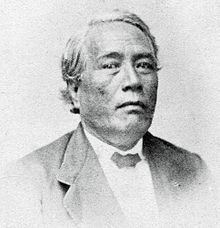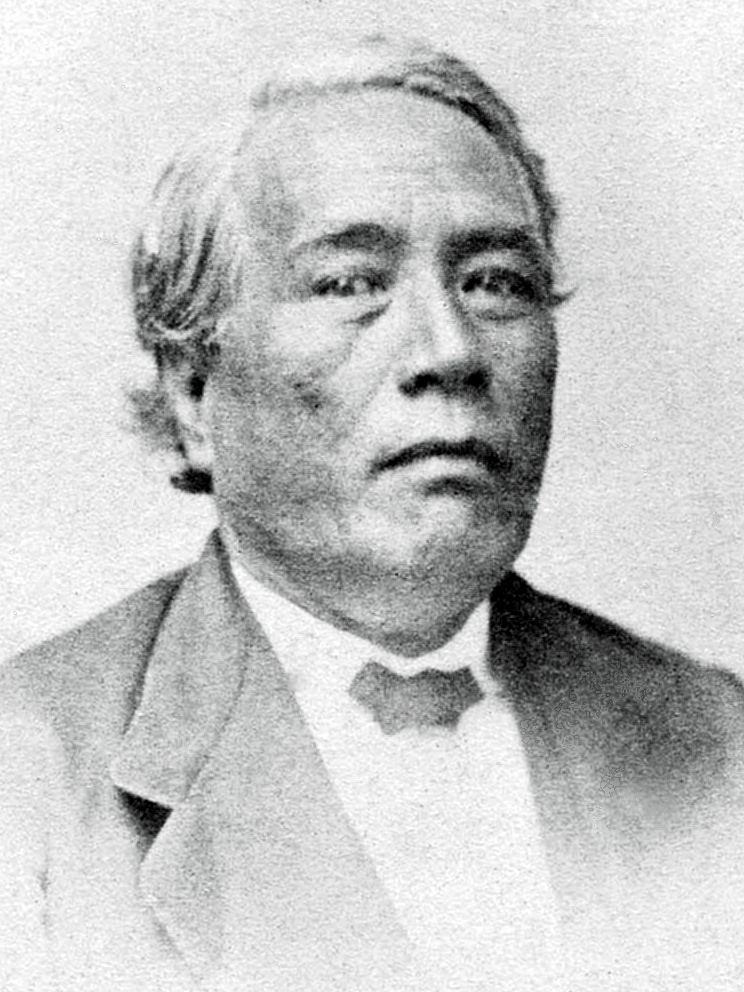Name Jonatana Napela | Died August 6, 1879 | |
 | ||
Born September 11, 1813 ( 1813-09-11 ) Spouse(s) Kitty Keliikuaaina Richardson Children Harriet Panana Kaiwaokalani Napela Parker Relatives Samuel Parker (son-in-law) Parents Wiwiokalani, Hawaiʻiwaaole | ||
Jonatana Napela or Jonathan Hawaii Napela (first name also spelled Iohatana, full name Napelakapuonamahanaonaleleonalani) (September 11, 1813 – August 6, 1879) was one of the earliest Hawaiian converts to The Church of Jesus Christ of Latter-day Saints (LDS Church) in Hawaii, joining in the 1830s. He helped translate the Book of Mormon into the Hawaiian language, as "Ka Buke a Moramona," working with missionary George Q. Cannon. Napela was appointed to serve as a superintendent of the colony at Kalaupapa, Molokaʻi, which he did for several years. He had accompanied his wife there after her diagnosis with leprosy. While at the settlement, he led LDS Church members and collaborated with Roman Catholic priest-missionary Father Damien to serve all the people of the settlement. Most were Protestant.
Contents

Life
Napela was born September 11, 1813, to Hawaiʻiwaaole and Wiwiokalani; his father descends from Kuahaliulani, one of the numerous sons of Kekaulike, king of Maui at the beginning of the 18th century. He was educated at Lahainaluna School.
Napela was trained as a lawyer. He was serving as a judge in Wailuku, Hawaii, when he met American George Q. Cannon, a member of the LDS Church on a missionary trip to Hawaiʻi. After Napela's conversion in the 1830s to the LDS Church, the government forced the judge to resign from his position. The LDS Church was regarded with suspicion.
LDS Church historian Andrew Jensen said that Napela "did splendid missionary work for the Church." Napela was sent on a specific mission in 1853 but, as was common in the early church, spent much of his time before that preaching the gospel. His faith inspired others. On one occasion, Cannon and other American elders had prayed for good weather but, thinking the weather would be poor, walked to hold the meeting in a building. Napela, who had been present at the prayers, expressed surprise at their lack of faith; they followed his lead and held the meeting in a grove of trees.
Decades later, Cannon returned to Hawaiʻi to consult with natives on translating the Book of Mormon from English into the Hawaiian language. Beginning in January 1853, he worked with Napela. Cannon would first render the text of a few pages into Hawaiian. Then he would discuss the meaning of the pages with Napela. Then Cannon would ask Napela to explain the meaning of the translation to ensure the sense was being expressed.
Napela was a vigorous preacher of Mormonism in the islands. He was among the men who reported to church headquarters their fears that Walter M. Gibson was leading the church astray. Ezra T. Benson, Lorenzo Snow and Joseph F. Smith traveled to Hawaii to excommunicate Gibson and put the church in order. In 1866 Napela traveled to Salt Lake City, meeting numerous church elders.
In 1873, Napela's wife Catherine "Kitty" Keliʻikuaʻāina Richardson was diagnosed with leprosy. Under laws of the period requiring quarantine of persons with leprosy, she had to relocate to the settlement of the Kalaupapa Leper Colony on Molokai. He accompanied her. His wife was the only mixed-race woman of partial European descent admitted to the colony that year; most residents were full-blooded Hawaiians.
Napela was appointed that year by the Board of Health as superintendent of the leper colony. He ran into trouble for failing to enforce the Board's demands for rigid segregation of lepers and non-lepers in the settlement and was replaced by William P. Ragsdale. For the rest of his life, he administered to members of the LDS Church at the colony. He died of leprosy on August 6, 1879.
